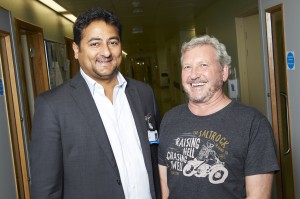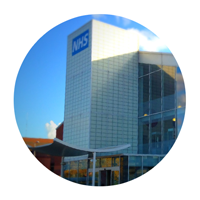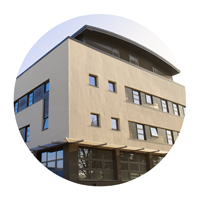A man from Warwickshire has a new lease of life after a team from Birmingham Heartlands Hospital successfully implanted a custom built 3D-printed titanium sternum and ribs to replace those that were removed following a rare bone infection six years ago.
60 year-old Edward Evans’ story featured on BBC2’s Trust Me, I’m a Doctor on Wednesday 1 February.
Edward is the first patient in the UK to receive this type of implant, and only the second in the world. He became ill and surgeons had to remove part of his sternum and ribcage in 2011 after it became infected. Edward, a keen sportsman and former rugby coach, felt vulnerable with just a thin layer of muscle protecting his heart and lungs.
The usual technique for protecting these organs and restoring chest wall movement, following the removal of the sternum is to replace it with an implant made of methyl methacrylate (cement), but only after the infection is eradicated.
Cardiothoracic surgeon, Mr Ehab Bishay, from Heart of England NHS Foundation Trust, had read of the world’s first 3D implant by a team of surgeons in University Hospital Salamanca, Spain. They had collaborated with Australia-based medical device company, Anatomics, creating a custom built titanium implant that precisely replicated the structure of a sternum and rib cage in a cancer patient which was then implanted.
Mr Bishay said: “We approached Anatomics initially, who put us into touch with the team from Salamanca to learn from their experience. It was a real multinational collaboration between surgical units as well as industry using the latest technology.”
The team in Australia used high-resolution CT scans of Edward’s chest to recreate the defect so that the implant would precisely fit. This data was then fed into a 3D printer that uses a powerful electron beam, to melt and fuse metal powder into a 3D object, layer by fine layer.
“Although cement is tried and tested we believe that custom built 3D printed titanium implants may have certain advantages which we are looking to show”, Mr Bishay continued: “Titanium is more resistant to infection, lightweight, tough, and since it exactly replicates the defect, it means that the operative time is reduced as it slots in. It should also offer a better cosmetic result.”
The Heartlands team, using the latest advances in chest wall dynamic imaging and lung function assessments, were able to demonstrate a significant improvement in Edward’s chest wall movement and lung function.
The cardiothoracic surgeons were part of a multi-disciplinary team which included a plastic surgical team, led by Mr Haitham Khalil, as well as thoracic anaesthetists and specialist theatre nurses that carried out Edward’s four hour surgery last September. He recovered on a specialist thoracic ward with the help of nurses and dedicated physiotherapists.
Mr Bishay said: “We were very keen to reduce any chances of infection to Edward’s implant. As well the integral work carried out by Mr. Khalil and his team, covering the implant with healthy muscle, we made a number of refinements to the original implant used by the group in Spain. They had used a synthetic mesh behind the implant in the first operation, to reduce the chance of the lungs herniating between the titanium rods that replicated the ribs. Unfortunately that mesh became infected and they had to remove it during a second operation. Instead we asked Anatomics to coat these rods with porous polyethylene to add bulk so we did not have to use a mesh. This seemed to have worked with no signs of infection in Edward’s implant.”
Edward spent five days in hospital and now four months after his surgery, has made a full recovery.
Edward is very happy with the results and said: “I feel more confident now. My chest now feels like it did before. Whatever I do now — simple or difficult — I feel better doing it. I can even fall over, knowing that my heart and lungs are protected, and that’s something I couldn’t do before.
“I am very grateful to Mr Bishay for giving me the opportunity to take advantage of this new implant technology and thank him, Mr Khalil and the rest of the medical team involved for the excellent treatment I received at Heartlands Hospital before, during and after surgery.”








